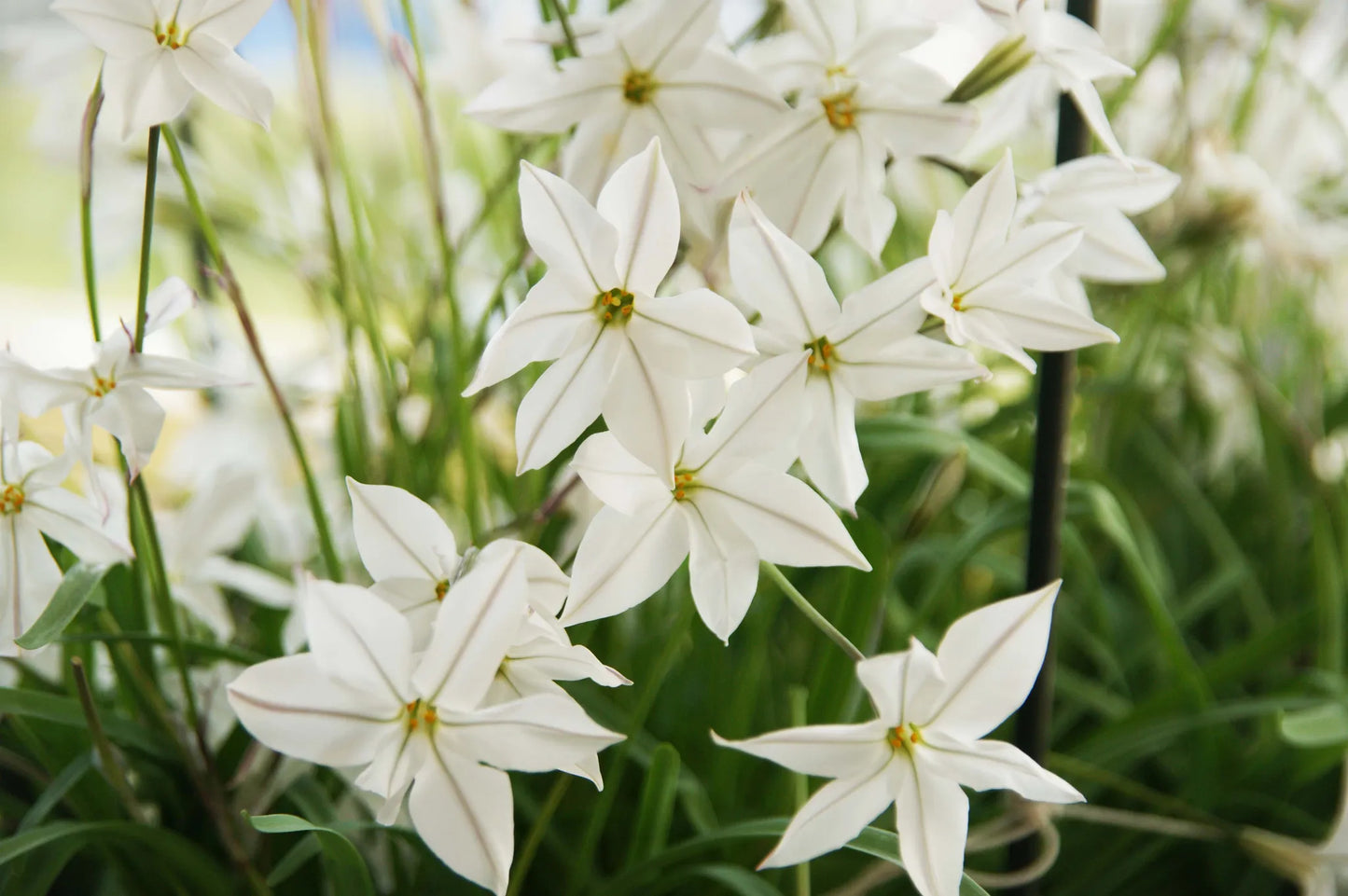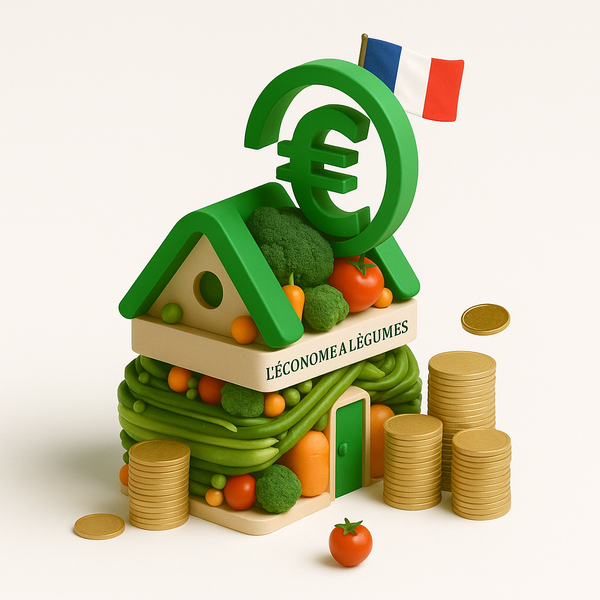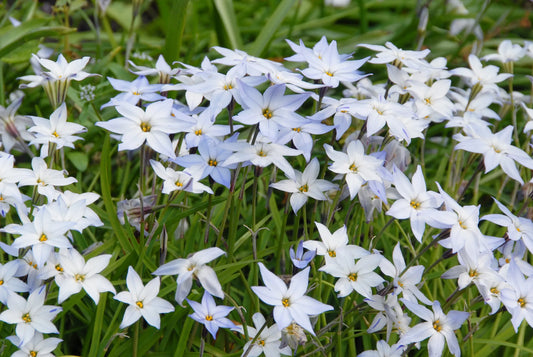-
Livraison dès 10 bulbes France, Suisse et Europe
Modalité livraison -
Grossiste Bulbes de fleurs en ligne
-
Bulbes de Qualité
-
Paiement sécurisé
Virement / chèques / Carte Bancaire /Chorus
Untreated flower bulbs Ipheion Alberto Castillo size 5/+ (3742000) for individuals
Untreated flower bulbs Ipheion Alberto Castillo size 5/+ (3742000) for individuals
PRICE per bulb € excluding VAT excluding transport
Free shipping on orders of 400 or more bulbs! 0.1€ discount per bulb on orders of 100 or more bulbs of all varieties.
Delivery from mid-September to November - choice at the basket stage
Online shopping available in France and Belgium. For other countries, please request a quotation.
Couldn't load pickup availability
 Limited stock - Buy now and get it delivered when you're ready to plant
Limited stock - Buy now and get it delivered when you're ready to plant
- Delivery from 10 bulbs to France, Switzerland and Europe
Flower Color:
Usage:
Flowering:
View full details

Quality Ipheion Uniflorum / Inca Garlic Bulbs for Floriculturists and Individuals
Quick read / the essentials on our Ipheion uniflorum bulbs
At Floriverse, a specialist wholesale supplier of flower bulbs, we provide floriculture professionals with a complete range of Ipheion uniflorum bulbs, also known as Spring Star. Our goal: to provide French producers with exceptional plant material, capable of meeting the growing demands of the local market. Buying Ipheion uniflorum bulbs allows you to introduce an original species, perfectly suited to short supply chains and differentiating winter productions. Its early flowering, its vigor and its melliferous attractiveness make it a solution of choice for ornamental crops or cut flowers in country bouquets.
As a specialist wholesale supplier of flower bulbs, we offer this species in three major segments: conventional, untreated, and certified organic. Our bulbs are rigorously selected for their hardiness (down to -15°C), their floridity (4 to 6 flower stems per bulb), and their ability to naturalize. Buying Ipheion uniflorum bulbs also means choosing a perennial species that is easy to manage, with flowering from February to May depending on weather conditions. For demanding flower growers, this plant represents a great opportunity to expand their range to include species with low competition and high decorative potential.
Finally, Floriverse, a specialist wholesale supplier of flower bulbs, is committed to providing dedicated technical support for every purchase. Thanks to our platform, purchasing Ipheion uniflorum bulbs becomes a simple, fast, and secure process. We pride ourselves on offering competitive prices, seasonal availability, and advice tailored to the realities of the field.
Introducing our range of Ipheion Flower Bulbs
At Floriverse, a specialist in flower bulbs for professionals, we offer a wide range of Ipheion flower bulbs suitable for specialized flower production. Our bulbs are available in three categories: conventional, untreated after harvest, and certified organic . This diversity allows flower growers to choose the route best suited to their growing practices and their customers.
Ipheion's wide range of organic flower bulbs meets growing demand from markets committed to sustainable practices. Selected from producers specializing in high-quality vegetative propagation, our bulbs guarantee consistent flowering, good hardiness, and strong honey-producing properties.
Market approach: The culture of the Ipheion in France
The Ipheion cut flower market in France remains a niche segment, not yet referenced in major statistical sectors. However, this perennial bulbous plant has a differentiating potential for professionals looking for originality.
Ipheion uniflorum (also called Tristagma uniflora) is prized for its early flowering (from December to May depending on the area) and its honey-producing properties. It comes in several cultivars ('Wisley Blue', 'Rolf Fiedler', 'White Star', etc.), with soft shades (blue, white, mauve), and fits perfectly into winter and early spring ranges.
General context of the French cut flower market
- Estimated value: €300 million per year
- 85% of flowers sold are imported
- Trade deficit: €320 million in imports vs. €20 million in exports (2022)
Recent developments
- Number of farms: 400 to 500 in 2022
- 183 million stems produced in 2020
- Professional retraining and post-Covid recovery
- Strong return of preference for local productions
Potential of the Ipheion
- Product not listed in the top 5 species
- Original winter bloom
- Ability to attract pollinators
- Valuable positioning in short circuits
Available production segments
- Organic : For certified producers and committed customers
- Untreated : Economic compromise for reasoned approaches
- Conventional : Large volume, optimized prices
Trends and opportunities
- Increased searches for local flowers
- Opening to new original species
- Possibility of promotion via the “Fleurs de France” label
Our sales arguments for floriculture professionals
At Floriverse, our mission is to offer a simple and seamless agricultural supply , without complications. Thanks to our responsive sales department , we guarantee a response within 48 hours with personalized and free quotes , including a complete technical itinerary upon request.
Our professional-quality Ipheion flower bulbs are sourced from specialist nurseries and offered at producer prices , with decreasing prices based on volume . Whether you're ordering for the first time or in large quantities, we ensure careful delivery throughout France, generally within 15 days during the season. It's also possible to reserve your bulbs in advance to secure your supplies.
Our dedicated technical support team assists florists with varietal selection and best growing practices. Whether online or wholesale, Floriverse's Ipheion flower bulb sales are aimed at demanding professionals who value value for money and impeccable service. As a floriculture specialist , we place your needs at the heart of our approach.
Technical presentation: Ipheion uniflorum, a bulbous species for sustainable production and development
Ipheion uniflorum , commonly known as Spring Star or Inca Garlic, is a popular bulbous plant in the professional horticultural and landscaping world. Its ease of cultivation , its early and abundant flowering , as well as its ability to naturalize make it a relevant choice for floriculturists, nurserymen, producers, green space departments of town halls, private estate managers, landscapers, park and garden directors, and horticultural managers wishing to enrich their offering or sustainably develop spaces. This technical presentation details the characteristics of the species and the optimal conditions for its professional cultivation in France, based on precise data from available technical sources.
Botanical and taxonomic data of Ipheion uniflorum
Validated name, synonyms and botanical family
Botanically, the full and validated name for the Spring Star is Ipheion uniflorum . This species also has synonyms sometimes encountered, such as Tristagma uniflorum or Triteleia uniflora . The classification of its botanical family has been the subject of debate, with some sources attaching it to the Liliaceae , others to the Amaryllidaceae , within the subfamily Allioideae , or even to the Alliaceae according to the IPNI.
Natural geographical origin
It is a bulbous plant native to South America , specifically the temperate regions of central-eastern Argentina and Uruguay.
Morphology and agronomic characteristics
Bulb: structure, multiplication, resistance
The storage organ of the Ipheion is a true bulb, of the tunicate type . Small in size, it is generally ovoid or ellipsoidal, measuring between 1.5 and 2.5 cm in diameter at maturity. Its outer tunic is dry and papery, brown to light beige in color, sometimes slightly silvery or golden. The interior, fleshy, is whitish. These bulbs multiply easily by natural division, producing lateral bulbils . A notable advantage is their resistance to rodents and deer .
Foliage: type, cycle and characteristics
The foliage of Ipheion uniflorum is linear and semi-erect , resembling blades of grass. The leaves are narrow, measuring 10 to 20 cm long and 2 to 4 mm wide. They have a fine, supple texture. Their color is a clear to medium green , without noticeable variegation. A distinctive characteristic is the onion or garlic odor they give off when crushed. The foliage is deciduous , appearing in late winter or early spring, persisting through flowering, then turning yellow and disappearing completely in late spring or early summer.
Flowering: shape, dimensions, colors, fragrance
The star-shaped flowers are the main attraction of the Ipheion. They are composed of 6 tepals fused at the base, then clearly separated. Each flower generally measures 3 to 4 cm in diameter, or even 4 to 5 cm depending on the source. They are carried at the end of thin flower stems reaching 7 to 15 cm in height. The dominant color varies from pure white to pale blue, lavender blue, purplish blue or periwinkle blue. Some horticultural cultivars offer shades of pink or violet. The tepals often have a darker midrib . They give off a pleasant, spicy or slightly sweet fragrance .
General habit, height and width of the adult plant
Ipheion uniflorum grows low and forms a vigorous clump . At maturity, the plant reaches a height of about 20 cm, while the flower stems rise between 10 and 15 cm above the foliage. The general habit is described as spiky, especially for the cultivars 'Alberto Castillo' and the botanical form. The width of a mature clump is about 10 cm.
Biological cycle and longevity in horticultural conditions
Seasonal course of the growing cycle
Ipheion is a perennial bulbous plant, capable of living and flowering for several consecutive years. Its typical cycle begins with the development of foliage in autumn or winter , followed by flowering in late winter and spring. After flowering, the foliage turns yellow and the plant enters summer dormancy . The bulbs multiply spontaneously, allowing the clump to thicken and persist.
Duration and precocity of flowering
Flowering is a major highlight of Ipheion for professionals. It is early and extends over a long period. It generally begins as early as February, reaches its peak in March to April, and can last until May. The total flowering time is about 8 weeks . In mild climates or in protected cultivation, the first flowers can appear as early as November. Each bulb produces several flower stems, which contributes to the abundance of flowering.
Ecological conditions and crop management
Natural habitat and climatic requirements
Native to Argentina and Uruguay, Ipheion uniflorum grows naturally in meadows and rock gardens , in open, sunny environments or on partially shaded edges. Its native range is characterized by a temperate climate , with mild to moderately cold winters and hot summers. The average annual rainfall is 800 to 1000 mm, well distributed, ensuring cool soil during the growing season .
Hardiness in French conditions
Ipheion is a hardy plant , capable of withstanding frost down to -15°C for the typical species, or even -20°C for certain cultivars such as 'Wisley Blue'. This allows it to be planted in open ground throughout France (USDA zones 5 to 9). In areas with harsh winters , the use of 4 to 5 cm of organic mulch is recommended after the first frosts to limit the effects of freezing/thawing.
Soil structure, drainage and optimal pH
The main requirement for Ipheion is well-drained soil . Excessive winter moisture is fatal. Sandy loam is ideal. In clay soil, deep amendment with neutral compost improves permeability. Very sandy soils can be enriched with peat. The optimum pH is between 6.5 and 7.0, with a tolerance of 6.0 to 7.0.
Recommended light exposure
Ipheion is adaptable but prefers full sun to partial shade . It requires at least six hours of direct light per day for optimal growth and flowering . Partial shade is tolerated but reduces flower yield.
Professional planting window in France
Planting bulbs is done in autumn , from September to November , when the soil temperature exceeds 8 to 10°C . This encourages good rooting before winter.
Planting depth and density
The bulbs should be planted at a depth of 5 to 10 cm (ideally 7 to 8 cm), with a spacing of 5 to 10 cm. For a rapid ground cover effect , use a reduced spacing of 5 cm .
Watering according to phases and fertilization needs
Watering needs are moderate but regular during autumn and spring. The soil should be slightly moist but not soggy. During the flowering period, the recommended water intake is 30-40 mm/week. During summer dormancy, drastically reduce watering .
For fertilization , the incorporation of well-rotted compost (2-3 kg/m²) before planting is beneficial. At the vegetative restart, an NPK 10-10-10 (30-40 g/m²) is recommended. In active growth: NPK 10-5-15 (20-25 g/m²). Before flowering: NPK 5-10-15 (20-30 g/m²). After flowering: NPK 5-5-15 (15-20 g/m²). Never put fertilizer at the bottom of the hole .
Routine maintenance, division and removal of foliage
Maintenance is minimal: well-drained soil and moderate watering are sufficient. Divide the clumps every 5 years in early summer . The foliage should be left in place after flowering to replenish reserves. Cutting should only take place when it has completely faded. Removing faded flowers is optional.
Managing extreme conditions: cold, drought, pot growing
In case of autumn or spring drought , keep the soil slightly moist. In harsh winters, plant 10-15 cm deep, add 5 cm of mulch. When growing in pots , very draining substrate based on peat, loam and perlite, moderate watering, liquid fertilization every 7-10 days.
Vernalization necessary for flowering
Ipheion requires a cold period to induce flowering. Exposure between 2°C and 7°C for 6 to 8 weeks seems adequate by analogy with other bulbs.
Specific conditions in soilless cultivation
In pots, you need a well-draining substrate (potting soil + peat + sand or perlite). Let the top 2.5 cm dry out before each watering. During summer dormancy, keep the pots cool, shaded and dry , or remove the bulbs.
Multiplication and yield in the nursery
Vegetative propagation by bulbils
Vegetative propagation is the preferred method: each bulb produces 1 to 3 bulbils/year under good conditions. A bulbil reaches flowering in 1 to 2 years.
Propagation by sowing and yields per m²
Sowing is possible but less reliable for preserving varietal characteristics. Flowering occurs after 2 to 4 years . For a rapid ground cover effect, plant 80 to 100 bulbs/m² . In 2 to 3 years, a clump can triple in size .
Varietal offer: main cultivars available
Several horticultural cultivars are available:
- 'Alberto Castillo' : pure white flowers, large, very hardy.
- 'Rolf Fiedler' : intense blue, fragrant, thick foliage.
- 'Jessie' : very dark blue, close to 'Rolf Fiedler'.
- 'Tessa' : dark pink, recent selection.
- 'Wisley Blue' : lilac blue.
Horticultural and landscaping applications
Flowerbeds, rockeries and permanent landscaping
Perfect for flowerbeds, slopes, borders and rockeries . Quickly forms flowering carpets . Resists diseases and pests . Low maintenance.
Use in public and collective spaces
Ideal for communities: long flowering , low maintenance , good resistance to cold . Useful for roundabouts, roadside verges, parks.
Cut flower potential
Early flowering (December-June), light fragrance , but short stems (15-30 cm) and limited vase life (4-6 days). Suitable for small bouquets .
Attractiveness to pollinators
Flowering from March to May : relay plant for domestic and wild bees , hoverflies , early butterflies .
Cultural associations and synergy effects
Blends well with Daffodils , Anemones , Muscari , Corydalis , Botanical Tulips . Similar requirements, cross benefits.
Post-flowering ornamental value
Weak. Foliage naturally yellows. Do not cut before complete wilting . Edible flowers and leaves (use not developed).
Regulatory, health and safety aspects
According to available sources, Ipheion uniflorum has no known toxicity to humans, domestic animals, or livestock. It is not listed as a protected or invasive plant in France. Its marketing and cultivation are therefore free. It is known to be robust and not very susceptible to major diseases or pests .
Bulb harvesting and storage conditions
Bulb harvesting takes place in summer (June-July) , when the foliage is completely yellow and dry, indicating dormancy. The bulbs must be carefully dug up , cleaned and sorted. This is the time to carry out division , separating the bulblets .
For storage, store the bulbs in a dry, dark, well-ventilated place at a stable temperature (15-20°C) . Use well-ventilated containers (crates, paper bags). Ipheion does not tolerate prolonged storage well , so it is recommended to replant quickly after harvesting or receiving.
For seed harvesting (breeding or hybridization use), sow immediately after harvesting ripe capsules (May-June).
Long-term crop management
Crop rotation and recommended precursors
Professional success depends on well-drained soil with a neutral pH . Avoid previous crops that leave poorly decomposed organic residues (fresh manure, hot compost). Do not replant after crops that are very sensitive to slugs and snails .
Visual indicators of plant health
A healthy bulb is firm and uniform in color (creamy-white to beige). The leaves should be green and ribbon-like (20-30 cm). A long flowering period (8 weeks), with several stems per bulb , is a sign of good health. Water stress manifests itself as wilting (underwatering) or premature yellowing (overwatering).
Nutrient deficiencies are manifested by pale foliage (nitrogen), purplish (phosphorus), or yellowed edges (potassium). A soft texture, strong odor, or discoloration of the bulb indicates rot due to excessive moisture.
Caution: Summer yellowing after flowering is natural and should not be confused with a deficiency or stress.
Influence of bulb size on production
Bulb size determines vigor and flowering capacity in the first year. The standard professional size is 4/+ cm . A size of 5/+ cm provides denser flowering and more vigorous plants. Sizes smaller than 4 cm produce few or no flowers in the first year, requiring several seasons to reach maturity .
To summarize: Our Ipheion uniflorum bulbs
The Ipheion uniflorum bulbs offered by Floriverse are a benchmark for floriculturists looking for an early, hardy, honey-producing species that can easily be integrated into existing technical itineraries. Buying Ipheion uniflorum bulbs means investing in a reliable perennial plant, ideal as a niche cut flower or as a perennial crop for landscaping. Cultivars such as 'Rolf Fiedler', 'Jessie', and 'Alberto Castillo' offer a range of pastel colors that are highly sought after in winter and spring. Thanks to their autonomous growth by bulbils, their longevity, and low maintenance, they ensure an excellent return on investment.
Floriverse, a specialist wholesale supplier of flower bulbs, guarantees professional quality, optimal sizing (4/+ or 5/+ cm), and controlled logistics. Buying Ipheion uniflorum bulbs from us also means benefiting from a seasonal reservation service, personalized technical support, and volume-based discounts. Our network of partner producers allows us to offer conventional, untreated, and certified organic bulbs, suitable for all types of production and the specifications of the most demanding professionals.
-
Untreated flower bulbs Ipheion uniflorum size 4/+ (3732500)
Regular price €0,04 EURRegular priceUnit price / per -
Untreated Ipheion Wisley Blue flower bulbs size 4/+ (3741000)
Regular price €0,08 EURRegular priceUnit price / per -
Untreated Ipheion Rolf Fiedler flower bulbs size 4/+ (3734500)
Regular price €0,08 EURRegular priceUnit price / per -
Ipheion Jessie® Untreated Flower Bulbs Size 4/+ (3741500)
Regular price €0,09 EURRegular priceUnit price / per -
Untreated flower bulbs Ipheion uniflorum size 4/+ (3732500) for individuals
Regular price €0,24 EURRegular priceUnit price / per
Floriverse: Online wholesaler of flower bulbs
-
-
Wholesale Flower Bulbs Online
We work with dozens of producers to offer you the best prices for your flower bulbs.
-
Quality
Our producers are selected for their reliability and the quality of their bulbs.
-
Your bulbs at the best prices
We work every year with your partner producers to offer you the best prices







